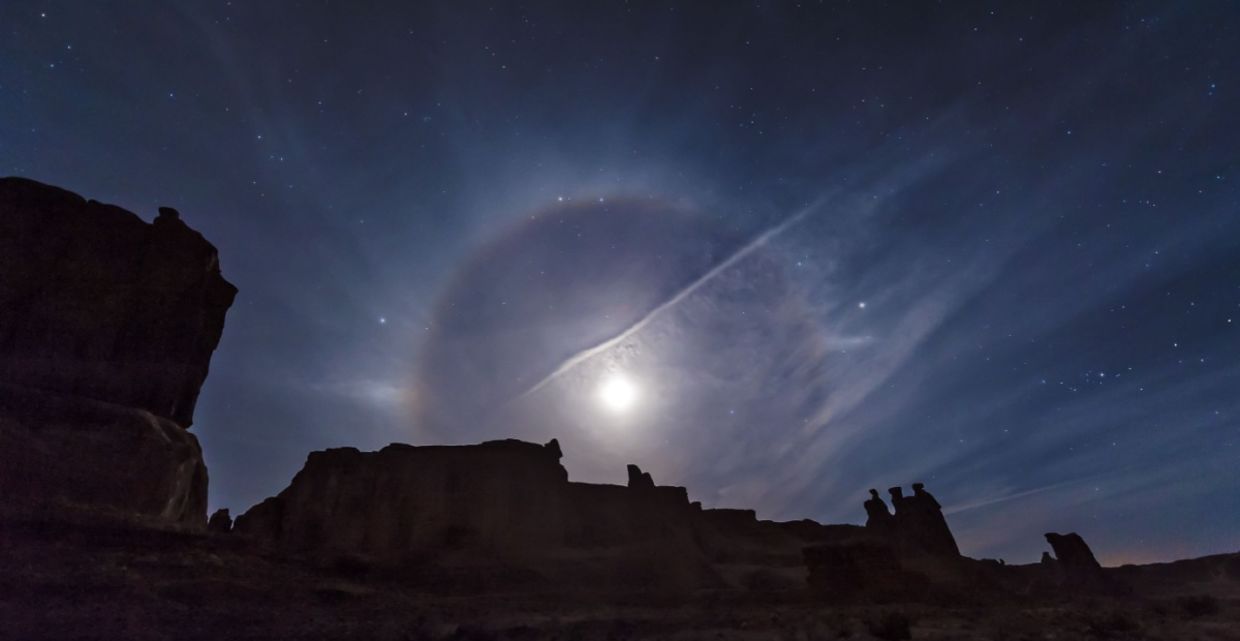
(John A Davis / Shutterstock.com)
With its ethereal glow and ever-changing phases, the moon has intrigued people throughout history. At times, the moon rises adorned by a perfect ring of light. This phenomenon, known as a moon halo, is yet another aspect of the moon’s beauty. Moon halos often accompany a winter’s full moon, an ideal time to venture out with a steaming hot cocoa for a special viewing!
What creates a moon halo?
Moon halos are formed by an intricate play of light and ice high in the atmosphere, according to Treehugger. These rings appear when moonlight interacts with tiny ice crystals floating in cirrus clouds that drift more than 20,000 feet (6 kilometers) above the Earth's surface.
These crystals, shaped like miniature hexagonal columns less than 20 microns across, bend and reflect the moonlight at precise 22-degree angles, creating the halo's circular shape. This process, known as refraction, occurs as moonlight enters each ice crystal and bends, then bends again as it exits the other side.
The space between the ring and the moon typically remains dark because ice crystals do not reflect light at angles smaller than 22 degrees. The lunar halo's colors appear dim because moonlight is 400,000 times less bright than sunlight, often making the ring appear milky white.
Understanding cloud conditions
LiveScience explains that while many people might mistake the halo for a vision problem, it is actually a natural phenomenon that is visible worldwide. These halos form in cirrus clouds and are so thin, you may not even observe that there are obvious clouds present. Cirrus clouds can form in two ways: either through warm air rising high enough to freeze into ice crystals, or by attaching to the tops of large storm clouds called cumulonimbus clouds.
The key to spotting a moon halo is having clear sky conditions with only a thin layer of cirrus clouds–if thicker clouds are present at lower levels, they will obscure the halo effect, explains Treehugger.
Measuring the moon’s halo
If you want to confirm that you are seeing a true moon halo, the Farmers’ Almanac suggests a simple measuring technique. Extend your hand to arm's length, spread your fingers wide, and cover the moon with your thumb. Your pinkie should reach the edge of the halo, marking the characteristic 22-degree radius. Unlike other lunar phenomena, this measurement remains consistent across the globe, making it a reliable identifier of genuine moon halos.
Just as observing a rainbow is personalized, everyone also sees their own particular moon halo; this is due to one’s orientation to the ice crystals, with the sight varying depending on personal height and viewing position, according to Treehugger. And the halo will remain visible as long as cirrus clouds create a veil across the moon.
Nature's weather predictors
While moon halos occur year-round, they appear more frequently during colder months in the Northern Hemisphere when ice crystal formation increases at high altitudes, according to Farmers’ Almanac. In fact, meteorologists have documented these halos frequently preceding storm systems.
According to weather lore, a ring around the moon means rain or snow is coming soon. This is not a folk story; cirrus and cirrostratus clouds are often the first sign of a warm front, meaning it is time for reach for an umbrella or snow boots.
Although many lunar phenomena are one-time events, moon halos can appear anytime during the year. The next time you spot an ephemeral ring around the moon, take a moment to appreciate this natural light show. Not only are you witnessing an elegant meeting of moonlight and atmospheric ice, you might also have a preview of tomorrow's weather.
YOU MIGHT ALSO LIKE:
‘Fire Rainbow' is Spotted in the Sky!
Rainbow Clouds Light up Polar Skies
How to Use the Moon's Phases to Live Your Best Life







